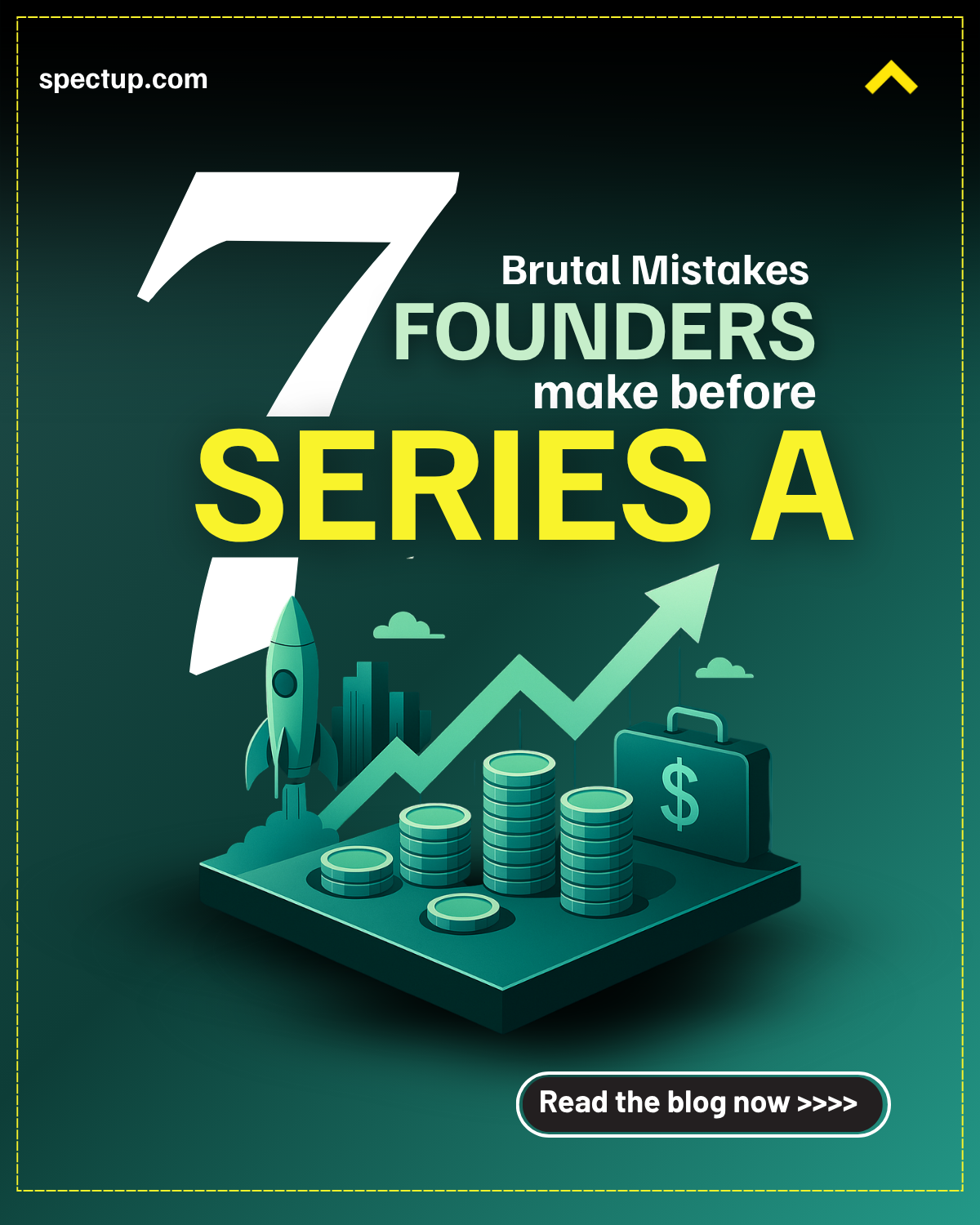7 Brutal Mistakes Founders Make Before Series A (And How to Fix Them Fast)

The journey to Series A funding is a pivotal phase for startup growth, where founders often encounter a myriad of challenges and opportunities. As founders gear up for this crucial funding round, they must navigate through the treacherous waters of fundraising with caution and precision. Avoiding common Series A mistakes before your first major funding round can mean the difference between scaling to new heights or facing stagnation
In this article, we delve into the 7 Brutal Mistakes Founders Make Before Series A and provide actionable insights on how to rectify them swiftly. By understanding these common pitfalls and learning how to sidestep them effectively, founders can enhance their fundraising success rate and position their startups for accelerated growth and scalability.
To further bolster their chances of success, founders should consider leveraging expert strategic insights from startup advisors, who can guide them through every stage from ideation to fundraising & growth. Additionally, understanding the various types of startups can help tailor strategies that suit specific business models.
Moreover, embracing innovative technologies like quantum computing could also fuel startup growth by revolutionizing security measures and driving innovation in various sectors.
Mistake 1: Over-Optimizing Fundraising Process and Terms
Founders often fall into the trap of obsessing over the fundraising process itself—specifically, chasing sky-high valuations or negotiating terms that look great on paper. It feels like winning a game, but here’s the catch: when you prioritize these over your company’s actual health, the risks multiply. Unrealistic expectations can lead to painful down rounds, where your startup’s valuation drops in subsequent funding rounds, damaging credibility and team morale.
Think about it this way: investors aren’t just buying into a number—they’re investing in how strong and sustainable your business is. The secret sauce? Focus on building solid fundamentals like product-market fit, revenue growth, and customer retention. A Lean Startup methodology could be beneficial here. Nail these first. When your business metrics shine, valuation becomes a natural byproduct rather than a forced target.
Ask yourself: are you polishing your company or just the fundraising pitch? Shifting your energy toward genuine growth sets the stage for better deals and long-term success. Remember, it's not just about negotiating favorable terms with your startup term sheet, but also understanding the intricacies of pre-money versus post-money valuations to protect your startup’s future. Additionally, having a clear distinction between your business plan and business model can further streamline your growth strategy.
Mistake 2: Failing to Create a Competitive Investor Environment
Creating a competitive environment among investors is a secret weapon many founders overlook. When multiple investors show genuine interest at the same time, your investor leverage skyrockets. This means you can negotiate better terms, valuations, and even secure strategic partners who align with your vision.
Ignoring this dynamic often leads to dealing with a single investor or scattered conversations. Without competition, you risk:
- Accepting less favorable terms
- Experiencing longer fundraising timelines
- Losing momentum and confidence in your startup’s potential
How do you spark this competitive fire? Use these fundraising strategy tips:
- Time your outreach so investors hear about your raise simultaneously.
- Create urgency by sharing deadlines or limited allocation.
- Share interest from other parties selectively to build FOMO (fear of missing out).
Imagine investors racing to be part of your story — that’s when you hold real power to shape the deal and accelerate growth.
However, it's not just about creating competition among investors. You also need to ensure that your startup is resilient enough to handle the pressures that come with rapid growth and increased scrutiny from potential investors. This is where building a resilient startup culture becomes crucial. By fostering a strong, cohesive culture even in a hybrid work environment, you pave the way for scaling startup leadership, a factor investors consider crucial during fast growth phases.
Mistake 3: Poor Pitching and Lack of Clear Vision
Pitching isn’t just about showing numbers or flashy slides — it’s storytelling with a purpose. Many founders stumble by delivering unclear storytelling or sounding like they’re reading from a script without passion. Investors want to feel your excitement and understand your unique insights wrapped in a clear vision.
A compelling pitch deck narrative stands out by connecting the dots between the problem, your solution, market opportunity, and why you are the right team to win. Ditch generic jargon and focus on authenticity — tell your story like you’re excited to share it with a friend, not just checking boxes.
Here are quick tips for crafting that authentic, concise pitch deck story:
- Lead with a strong, relatable problem that hooks attention.
- Showcase your unique insight or approach that others miss.
- Paint a vivid picture of the future with your product.
- Keep slides simple; let visuals support your message.
- Practice delivering with genuine enthusiasm.
Before you pitch, however, it's crucial to validate your startup idea using proven techniques. Mastering this part changes how investors see you — from “just another startup” to “the one we can’t miss.” This is why aligning your pitch with a clear go-to-market strategy that your startup team can rally around is essential.
Mistake 4: Using Unready or Template-Based Pitch Decks
When it comes to creating a pitch deck, using generic templates or relying on unready versions can be detrimental to your chances of success. Here's why:
The Dangers of Generic Pitch Decks
Generic pitch decks lack uniqueness and fail to capture the attention of investors. They often blend in with the countless other presentations that investors see on a daily basis. To stand out from the crowd, it's crucial to create a pitch deck that reflects your brand's personality and tells your unique story.
Understanding the Difference: MVP vs Scalable Product
One common mistake entrepreneurs make is presenting their Minimum Viable Product (MVP) as their long-term vision. While it's important to showcase your MVP and its potential, you also need to communicate how you plan to scale and grow your business in the future. This is especially important when pitching to Series A investors, as avoiding common Series A mistakes is crucial to demonstrating real growth potential.
Building a Customized Deck for Series A Investors
To resonate with Series A investors, it's essential to tailor your pitch deck specifically for them. Here are some key elements to include:
- Market Opportunity: Clearly define the market size and growth potential of your industry.
- Business Model: Explain how your business plans to generate revenue and sustain profitability.
- Traction Metrics: Highlight any significant milestones or achievements that demonstrate traction and validation.
- Competitive Advantage: Showcase what sets you apart from competitors and why you have a sustainable advantage.
By understanding the specific interests and concerns of Series A investors, you can create a customized pitch deck that speaks directly to them.
Remember, while templates can provide a starting point, it's important to go beyond them and create something truly unique that reflects your brand's story and vision. For instance, one startup managed to achieve remarkable success by crafting a personalized pitch deck that resonated with their investors.
Mistake 5: Targeting the Wrong Investors and Poor Pipeline Management
Approaching inappropriate or too few investors can lead to significant setbacks in your fundraising efforts. It's crucial to conduct thorough research on potential investors, understanding their fund focus and stage preferences before making contact. This is where targeted investor outreach comes into play, allowing you to find high-growth investment opportunities that align with your startup's needs.
Furthermore, building and managing an investor pipeline effectively is essential. This involves leveraging warm introductions and maintaining detailed CRM tracking to ensure that you're nurturing relationships with the right investors at the right time.
Mistake 6: Misunderstanding Venture Capital Timing and Psychology
Why Timing the Raise Matters
When it comes to fundraising, timing is crucial. You need to be strategic about when you start your fundraising efforts to maximize your chances of success. Here are a few reasons why timing matters:
- Avoiding holidays: Fundraising during holiday seasons can be challenging as many investors may be unavailable or preoccupied with their own plans. It's important to plan your fundraising activities around these holidays to ensure you have the maximum attention from potential investors.
- Compressing timeline: Investors are often busy individuals with multiple commitments. By compressing your fundraising timeline and setting a specific deadline for closing the round, you create a sense of urgency that can motivate investors to make quicker decisions.
Psychological Factors Influencing VC Decisions
Understanding the psychology behind venture capital decisions can give you an edge in your fundraising efforts. Here are a few key psychological factors that influence VC decisions:
- Fear of missing out (FOMO): VCs are always on the lookout for promising startups that they can invest in before others do. By creating a sense of scarcity and exclusivity around your fundraising round, you can tap into their FOMO and increase your chances of getting their attention.
- Social proof: Investors often rely on social proof to validate their investment decisions. If they see other reputable investors or successful entrepreneurs backing your startup, it can significantly boost their confidence in your business and make them more likely to invest.
Benefits of Running a Focused Six-Week Raise
One effective strategy to maintain momentum and urgency during your fundraising process is to run a focused six-week raise. Here's why this approach can be beneficial:
- Clear timeline: By setting a specific timeframe for your fundraising activities, you create a sense of structure and discipline that can help you stay focused and organized.
- Increased urgency: With a limited timeframe, both you and potential investors will feel a greater sense of urgency to make decisions and take action. This can lead to quicker responses from investors and ultimately faster funding.
- Better resource allocation: A focused raise allows you to allocate your time, energy, and resources more effectively. You can prioritize meetings with high-potential investors and dedicate specific days for outreach or follow-ups.
By understanding the importance of timing, being aware of the psychological factors at play, and implementing strategies like running a focused six-week raise, you can improve your chances of successful fundraising.
Mistake 7: Ignoring Investor Reference Checks and Lacking a Lead Investor
Skipping thorough investor reference checks is like signing a lease without reading the fine print—you might end up with unexpected headaches. Not vetting major investors can expose you to partners whose values or expectations clash with your vision, causing friction down the line.
A lead investor brings more than just capital: they set the pace for fundraising, boost your startup’s credibility, and help streamline communication between you and other investors. Without a lead, your raise can feel like herding cats—disorganized and slow.
Best practices for selecting trustworthy investment partners:
- Reach out to founders they've invested in before and ask about their experience
- Verify the investor’s history of support beyond money (advice, network access)
- Confirm alignment on company vision and long-term goals
- Look for investors who actively participate in deals as leads or co-leads
Choosing the right investor isn’t just about money—it’s about building a partnership that accelerates your growth with trust and shared ambition.
Additional Common Pitfalls to Avoid Before Series A
Founders often stumble by accepting misguided advice or even fabricating data to impress investors. This might seem like a shortcut, but it’s a trap that destroys trust and can haunt your startup long term. Investors value honesty and transparency, they want to see real numbers, not fairy tales.
Transparent startup financial modeling is crucial. It means showing clear, realistic projections that demonstrate how your business will grow revenue predictably. Avoiding classic Series A mistakes, like inflating projections or hiding weak metrics, is essential at this stage. Investors at the Series A stage are hunting for metrics that prove your model isn’t just smoke and mirrors. They want to understand your path to sustainable growth, especially predictable revenue for Series A that de-risks their investment.
In this context, adopting innovative revenue models for startups could be beneficial. These models go beyond traditional approaches and can provide the predictable revenue growth backed by data that investors are looking for.
Cap table issues are another common headache. A messy cap table with unclear ownership stakes or complicated option pools raises red flags. Clean, well-organized cap tables signal you’re serious about governance and future fundraising rounds.
To navigate these challenges, seeking guidance from experienced professionals can be invaluable. This is where fractional CFO services come into play. They provide scalable financial leadership that can help businesses make smarter financial decisions, streamline operations, and scale with confidence.
Additionally, exploring cutting-edge fintech trends such as blockchain technology could open up new avenues for growth and innovation in your startup.
Ask yourself:
- Are my financial models easy for investors to follow?
- Does my cap table reflect a solid, fair structure?
- Can I show predictable revenue growth backed by data?
Getting these right makes your startup a much more attractive bet when investors ask, What do you look for in Series A?"
How to Fix These Brutal Mistakes Fast
- Focus on strengthening company fundamentals over fundraising hacks
- Develop an authentic narrative aligned with go-to-market strategy and scalable product vision
- Build strategic investor relationships with targeted outreach and warm introductions
- Maintain respectful communication and create competitive dynamics among investors
- Time the raise strategically while securing a lead investor early
For instance, if you're a part of the green tech startups sector, focusing on these strategies can significantly improve your chances of success when preparing for Series A funding.
Founders often make critical errors such as over-optimizing fundraising terms over business fundamentals, failing to create a competitive investor environment, poor pitching with unclear vision, using unready or template-based pitch decks, targeting the wrong investors with poor pipeline management, misunderstanding venture capital timing and psychology, and ignoring investor reference checks while lacking a lead investor.
Over-optimizing fundraising process and terms can lead founders to set unrealistic expectations, resulting in down rounds or unfavorable deals. It's essential to refocus on building strong company fundamentals rather than solely chasing high valuations or specific deal terms to ensure sustainable growth and successful fundraising.
Generating competition among investors is critical for maximizing leverage and securing favorable terms. Founders should engage multiple interested investors simultaneously, create urgency through strategic communication, and foster a dynamic fundraising atmosphere that encourages investors to act promptly and competitively.
An effective pitch deck for Series A should present a clear and compelling narrative with unique insights that excite investors. By understanding what investors look for in Series A, you can give your pitch the clarity and edge it needs. The deck must differentiate between showcasing an MVP and a scalable product vision, avoid generic templates, and authentically communicate the startup's story aligned with its go-to-market strategy.
How important is timing in the Series A fundraising process?
Ignoring investor reference checks can expose startups to partnership risks. Conducting thorough vetting ensures trustworthy investment partners. Securing a lead investor early improves operational cadence, enhances credibility with other investors, and provides strategic guidance throughout the fundraising process
Concise Recap: Key Insights

Ready to Take the Next Step?
Whether you're a startup looking for funding or an investor seeking prime opportunities, we're here to help.
Contact Us
.png)

